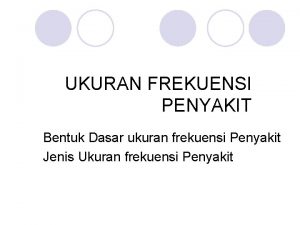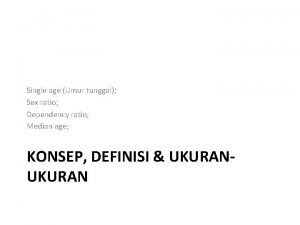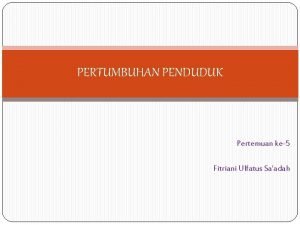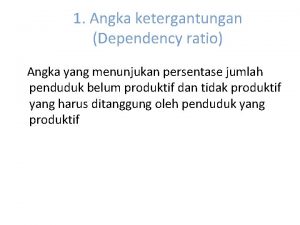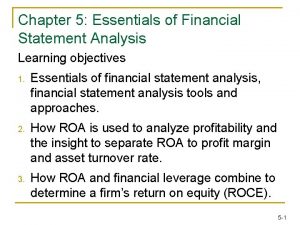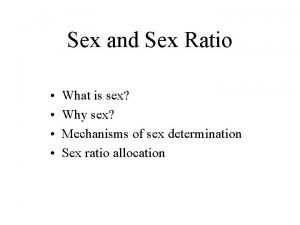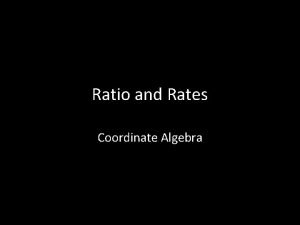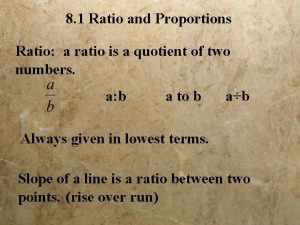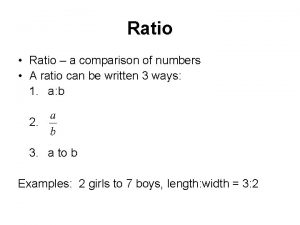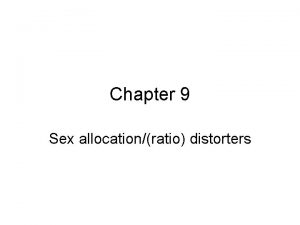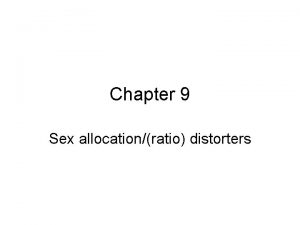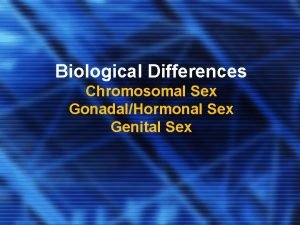Evolution of Sex Sex Ratio Evolution of Sex




















- Slides: 20

Evolution of Sex & Sex Ratio Evolution of Sex: 1) Group Selectionist Argument: • • mutations rare then sexual asexual mutation rate high sexual > asexual Gain to group (fast evolution) outweighs loss to ind. (decrease in repro) Evidence: asexual forms scattered in phylogenies Suggests: extinction rate asexual >sexual

Big Problem Benefit to group over individual? Not impossible but ind. selection - more powerful

Heterogenic Species Asexual when stable conditions, sex must be advantageous to individual if used “Balance Argument” - both sex & asexual repro have advantages or one would be lost from spp.

Non-group selectionist argument • 2 alleles: S = sex, s = asex • When is S better than s? – Stable environment: s > S – Unstable environment : S > s Why?

2 Individual Advantage Hypotheses 1) Reduction of Deleterious Mutations • 2 loci: 1 = allele with high fitness 0 = allele with low fitness

Fitness: Independent Effects Genotype 11 10 01 00 Fitness 1. 0 0. 9 0. 81 Generally, frequency of deleterious mutations is equal in asexual & sexual populations. Asexual females: offspring have same frequency of mutations as self. Sexual: females lose half their deleterious mutations through meiosis but then gain half from the males. Thus, no advantage to sex.

Fitness: Synergistic Effects Genotype 11 10 01 00 Fitness 1. 0 0. 9 0. 7 High frequency Low frequency

Sexual Populations 10 01 11 10 01 00 Can make new 11 by recombination! Sexual organisms can “dump” deleterious mutations

Requirements 1. Mutation rate needs to be high enough • • Approximately 1/individual Higher than any shown so far 2. Must have synergistic effects • No experimental support but theoretically likely

2) Parasite – Host Coevolution • Sex more likely advantageous if env’t changes rapidly • Change fast enough to maintain sex at every generation Parasite: host resistance = environment Host: parasite attack = environment

Haploid Model • 2 alleles in each of host (H 1, H 2) & parasite (P 1 , P 2) • P 1 infects H 1 & P 2 infects H 2 P 2 Sex allows reassembly of multilocus genotypes that vary in fitness Sex forms increase in frequency when parasite pressure increases P 1 H 2

Two Locus Model 4 Haplotypes: Host AB Ab a. B ab Parasite ab AB Ab a. B Loci control cell-surface molecules A can invade a , a can invade A B can invade b , b can invade B

• Fitness of host/parasite depends on frequency of parasite/host • Sex allows recombination of genotypes that were once unfavourable but now favourable • Not possible in asexual populations

Example • If Ab lost at low trough in cycle, in asexual can be lost forever, in sexual can be reformed by recombination

Requirements 1. Parasitism in almost all species 2. Multilocus gene for gene parasite-host relationship 3. Not enough info for conclusions

Sex Ratio (Fisher) • Usually 1: 1 (zygote) but WHY? • Most species: M could fertilize > 1 F • 1: 1 is inefficient

Consider… 4 F : 1 M Avg # offspring/F = 2 Avg # offspring/M = 8 M > success F that produce more M success Mutant F produces only sons = 2. 5 x success Expect mutation to spread, thus F bias EQUILIBRIUM at 50: 50

• • 1: 1 is ratio of cost not numbers Suppose cost of 1 M = 2 F Sex ratio will skew so, 2: 1; F: M Ratio of investment in M & F offspring will be 1: 1 • Applies to pop’ns but what about individuals?

Local Mate Competition (Hamilton 1967) • Assume population-wide competition for mates • Thus, avg. M expects avg. repro success • e. g. Matriphagous mites/Parasitic Wasps – 1 female; 1 host – Brothers compete for mating (fruitless competition) – Sex ratio = 4 M : 86 F

Trivers/Willard Hypothesis • Polygynous males – skewed repro success • Differences in condition affect male RS more than female RS • If F “knows” she is high quality should # M • F should invest in sex of offspring based on personal circumstances • e. g. Red Deer of the island of Rhum (Clutton-Brock)
 Secondary sexual characters
Secondary sexual characters Sex sex sex
Sex sex sex Sex sex sex
Sex sex sex Sex sex sex
Sex sex sex Sex sex sex
Sex sex sex Once a sex offender always a sex offender
Once a sex offender always a sex offender Y chromosome traits
Y chromosome traits Sex rat
Sex rat Sex determination and sex linkage
Sex determination and sex linkage Persebaran penduduk
Persebaran penduduk Sex ratio in odisha
Sex ratio in odisha Youth dependency ratio ap human geography
Youth dependency ratio ap human geography Sex ratio aphg
Sex ratio aphg Rumus sex ratio
Rumus sex ratio Rumus sex ratio
Rumus sex ratio Dependency ratio rumus
Dependency ratio rumus Rumus sex ratio adalah
Rumus sex ratio adalah Piramida dependency ratio
Piramida dependency ratio Ukuran asosiasi adalah
Ukuran asosiasi adalah Acid test ratio and quick ratio
Acid test ratio and quick ratio Current ratio and quick ratio
Current ratio and quick ratio













